Planning for Change
or
Gee, Those Little Trees Look Silly
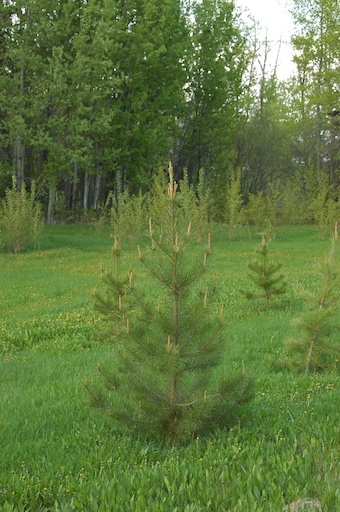
They started as seedlings 8 feet apart. "Lots of room," I thought.
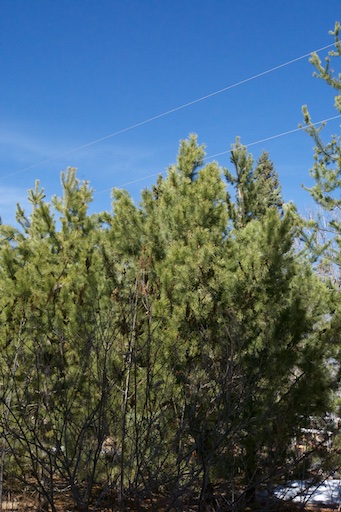
Maybe they are a bit too close...
I keep forgetting that plants grow. Have you ever brought a few flats of bedding plants home, put them out, and then looked at all that space between them?
Back to the store for another few flats. Carefully tuck them in between the ones you already planted.
Then by August they have reached their mature size, and are crammed together cheek by jowl. And you promise yourself to leave space next year. So next year you remember with the marigolds, but forget with the lilies...
I've seen it happen with trees too, but it takes a lot longer than just August.
You don't expect a garden to look uniformly good from spring to frost.
Why expect it with trees. However, being humans, we are impatient,
especially with the time scale required by trees. (My tree farm IS
teaching me patience.) We need to think of trees as providing dynamic landscape.
Landscape that not only changes with the seasons, but changes with the years.
So we'll add things for now, and take them out later.
There is a small town that passes for our nearest point of civilization (It has
a gas station, a cafe, and a library. That's civilization enough.)
One of the houses has a row of white spruce along the street, planted about
four feet apart. Now some are dying. Too much competition for water.
The branches are growing into each other. While it's effective as a barrier
to the street, it doesn't have a lot of class. What they could have done
when the trees started to grow into each other was to take out alternate trees,
leaving room for the remainder.
One of my customers bought 80 white spruce. He was going to put 40 on either side of his driveway, 8 feet apart. I tried to get him to see that in 30 years his driveway would be a dark canyon. I hope he doesn't wait too long before culling.
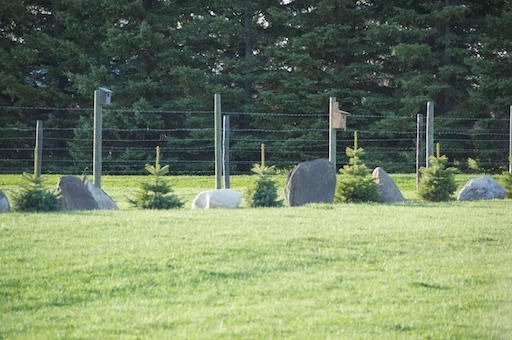
They were even smaller than this when he planted them, about 5 years before this shot.
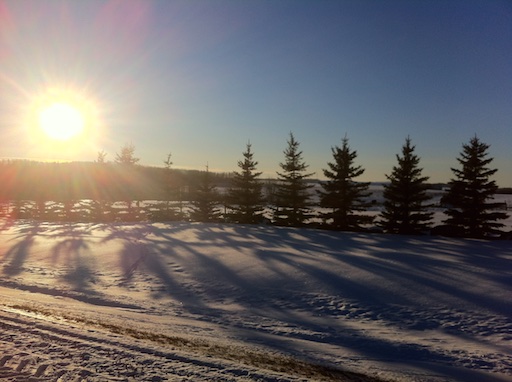
Now they are ten years older. They are about 15 feet tall. Reg said he wished he had put them further apart.
A neighbor got a bunch of spruce on sale at Canadian Tire (and he chose well: most of them made it. Better luck than I have with CT trees.) He's put them 16 feet apart. The first two years they looked silly. 16 feet of space, and this 1 foot high tree, then 16 more feet of space. Then he did something clever: To fill in the space between to keep them from looking too silly, he's put a large stone from his field. (Both our properties grow a fine crop of rocks most years.) The rocks add a balance to the row.
Another neighbour put in two rows of spruce 16 feet apart, with the second row staggered. This looks good both when they are little and when they are big.

Tiny trees look way too small. It may seem like I'm beating this point to death. I am. I want happy trees.
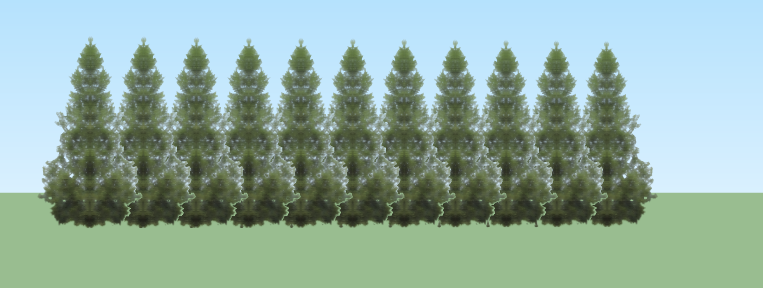
Later they are too crowded. The branches will beat on each other. They will fight for water. Some will die. That in a spaced row looks like a NHL player's smile before helmets and faceguards.
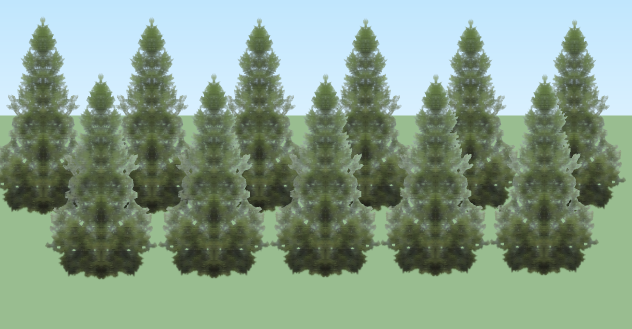
This is how you deal with the problem. Put in two rows. Don't have to be same.
Another option is alternate planting a slow growing and a short lived fast growing tree. This can look striking. Imagine a row of spruce with a row of birch set off in front a bit. When young, the birch grows fast (You gotta water birch. A lot.) Initially they dominate the row. The spruces take their time, but eventually they will tower over the birch, making a dark wall to contrast against the white bark.
An acreage on the way to the Big City (Edmonton) planted Colorado spruce as a hedge. Now I've been told this works. But they used spruce seedlings. Colorado spruce can vary from a pale blue white, to an almost steel blue, to a dark green, to a pale green, to almost chartreuse, with most of the wild stock being dark green to blue green. You can't tell what colour they will be until they are several years old. This acreage doesn't have two trees the same colour next to each other. It looks awful. You wonder if some are sick.
What they should have done was to get cloned stock -- named cultivars with predictable colour. (You'll have to go elsewhere. My experiments with spruce cloning have been dismal failures so far.) Or they should have used natural stock of a species that doesn't exhibit such strong variation.
Another acreage has a driveway lined with alternating green and purple leaved versions of the same species. It's spectacular, especially in the spring when they are in bloom. But there is one purple leaf tree that's only half the size of the rest. THAT sticks out like sore thumb, and ruins the effect. Fortunately it's at the far end of the drive, so I suppose most people don't notice.
Lessons:
- Trees need room. Do your homework, find out how big they'll get. Leave them enough room, and let them grow into it.
- Fill in the space with short lived trees that can be removed later. Or use shrubs as filler. As the tree grows, you may need to replace sun loving shrubs with ones that are shade tolerant.
- Unless you have something that is unkillable, avoid putting in long rows of identical trees. Think in terms of planting a less evenly spaced strip of forest, instead of a perfect row.
- Two rows at wider spacing almost always works better than a single row. If one of them dies or is stunted, it will only be noticeable from certain angles.
- Alternating species in a row minimizes variation within the same species.
Got something to say? Email me: sfinfo@sherwoods-forests.com
Interesting? Share this page.
Want to talk right now? Call me: (8 am to 8 pm only, please) 1-780-848-2548
Do not arrive unannounced. Phone for an appointment. Why? See Contact & Hours That same page gives our hours of operation.
Back to Top
Copyright © 2008 - 2021 S. G. Botsford
Sherwood's Forests is located about 75 km southwest of Edmonton, Alberta. Please refer to the map on our Contact page for directions.
